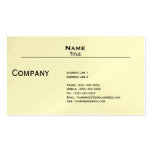Organization & Management
Organization and Management follows the Market Analysis section. This section should
include: your company's organizational structure, details about the ownership of
your company, profiles of your management team, and the qualifications of your
board of directors.
Who does what in your business? What is their background and why are you
bringing them into the business as board members or employees? What are they
responsible for? These may seem like unnecessary questions to answer in a one-
or two-person organization, but the people reading your business plan want to
know who's in charge, so tell them. Give a detailed description of each division
or department and its function.
This section should include who's on the board (if you have an advisory
board) and how you intend to keep them there. What kind of salary and benefits
package do you have for your people? What incentives are you offering? How about
promotions? Reassure your reader that the people you have on staff are more than
just names on a letterhead.
Organizational Structure
A simple but effective way to lay out the structure of your company is to
create an organizational chart with a narrative description. This will prove
that you're leaving nothing to chance, you've thought out exactly who is doing
what, and there is someone in charge of every function of your company. Nothing
will fall through the cracks, and nothing will be done three or four times over.
To a potential investor or employee, that is very important.
Ownership Information
This section should also include the legal structure of your business along
with the subsequent ownership information it relates to. Have you incorporated
your business? If so, is it a C or S corporation? Or perhaps you have formed a
partnership with someone. If so, is it a general or limited partnership? Or
maybe you are a sole proprietor.
The following important ownership information should be incorporated into
your business plan:
- Names of owners
- Percentage ownership
- Extent of involvement with the company
- Forms of ownership (i.e., common stock, preferred stock, general partner, limited partner)
- Outstanding equity equivalents (i.e., options, warrants, convertible debt)
- Common stock (i.e., authorized or issued)
- Management Profiles
- Experts agree that one of the strongest factors for success in any growth company is the ability and track record of its owner/management team, so let your reader know about the key people in your company and their backgrounds. Provide resumes that include the following information:
- Name
- Position (include brief position description along with primary duties)
- Primary responsibilities and authority
- Education
- Unique experience and skills
- Prior employment
- Special skills
- Past track record
- Industry recognition
- Community involvement
- Number of years with company
- Compensation basis and levels (make sure these are reasonable -- not too high or too low)
- Be sure you quantify achievements (e.g. "Managed a sales force of ten people," "Managed a department of fifteen people," "Increased revenue by 15 percent in the first six months," "Expanded the retail outlets at the rate of two each year," "Improved the customer service as rated by our customers from a 60 percent to a 90 percent rating")
Board of Directors' Qualifications
The major benefit of an unpaid advisory board is that it can provide expertise that your company cannot otherwise afford. A list of well-known, successful business owners/managers can go a long way toward enhancing your company's credibility and perception of management expertise.
If you have a board of directors, be sure to gather the following information when developing the outline for your business plan:
- Names
- Positions on the board
- Extent of involvement with company
- Background
- Historical and future contribution to the company's success















No comments:
Post a Comment